By Lambert Strether of Corrente.
Patient readers, today’s Water Cooler will be a mere template, since I must hasten to finish a post on the Delta variant. Talk amongst yourselves! –lambert
Bird Song of the Day
It is said that birds descended from dinosaurs. But it’s hard to imagine dinosaurs singing. I wonder when they learned, and why?
#COVID19
At reader request, I’ve added this daily chart from 91-DIVOC. The data is the Johns Hopkins CSSE data. Here is the site.
I feel I’m engaging in a macabre form of tape-watching. I’ve been thinking of new charts to monitor to alert us to the next outbreak, assuming there is one, but for now, the data from the South means I’ll stick to the status quo.
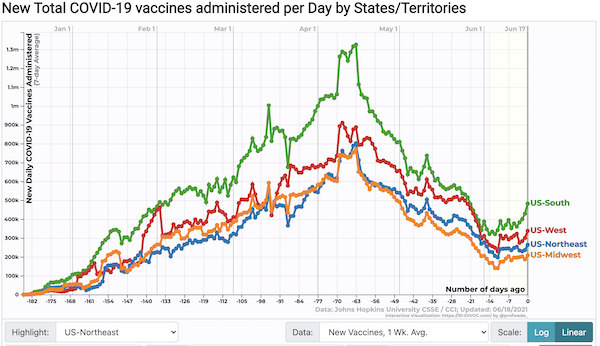
Up and down, up and down, with a rising trendline, and an uptick in the South.
Case count by United States regions:
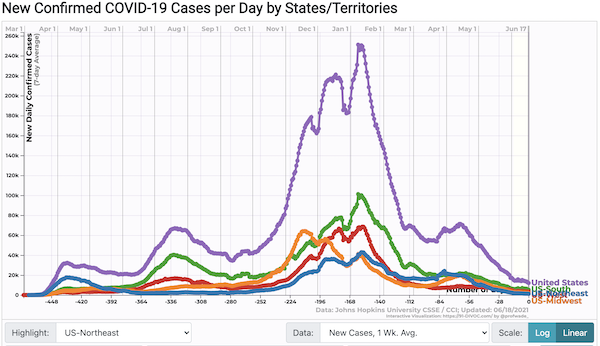
Decline has resumed.
Good news from Montréal, a thread:
1) Montreal on Thursday reached another turning point in the #COVID19 crisis, but this time one in which all indicators were pointing dramatically toward the #pandemic coming under full control. In this thread, I will report on these heartening developments.
— Aaron Derfel (@Aaron_Derfel) June 18, 2021
Here are the case counts for the last four weeks in the South (as defined by the US Census: Alabama, Arkansas, Delaware, Florida, Georgia, Kentucky, Louisiana, Maryland, Mississippi, North Carolina, Oklahoma, South Carolina, Tennessee, Texas, Virginia, West Virginia, and the District of Columbia):
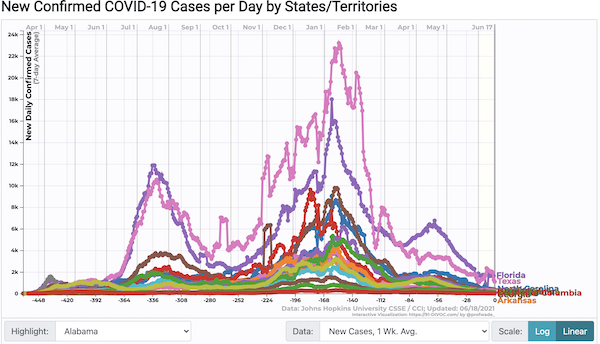
Texas seems to be fizzling out, but Florida, capital of Latin America, is not.
Big states (New York, Florida, Texas, California):
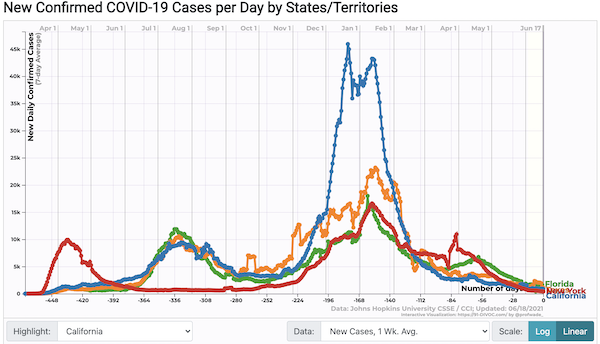
Not entirely good news.
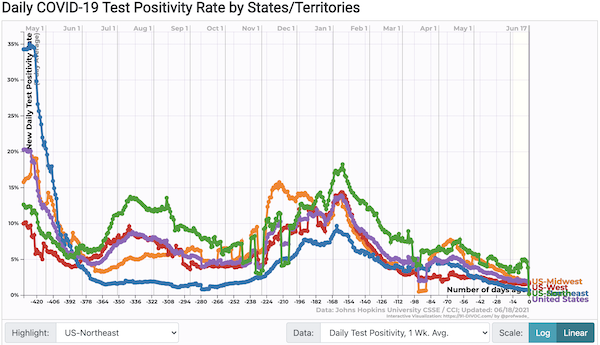
South positivity falls off a cliff. Huh?
Hospitalization (CDC):
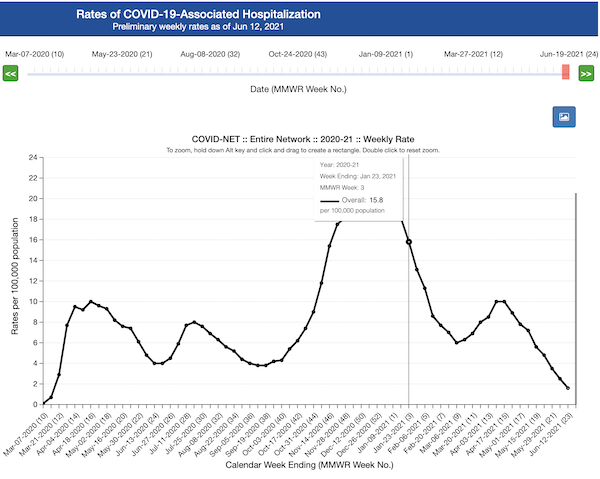
Continued good news.
Deaths (Our World in Data):

Continued good news.
Covid cases worldwide:
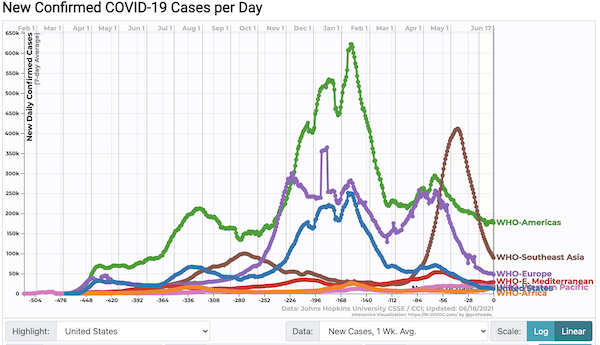
It looks to me like al the regions have had three peaks, although of different heights and at different times. Except Southeast Asia, which has had two. I hate the idea that India could suffer even more, but….
Readers, feel free to contact me at lambert [UNDERSCORE] strether [DOT] corrente [AT] yahoo [DOT] com, with (a) links, and even better (b) sources I should curate regularly, (c) how to send me a check if you are allergic to PayPal, and (d) to find out how to send me images of plants. Vegetables are fine! Fungi and coral are deemed to be honorary plants! If you want your handle to appear as a credit, please place it at the start of your mail in parentheses: (thus). Otherwise, I will anonymize by using your initials. See the previous Water Cooler (with plant) here. Today’s plant (SC):
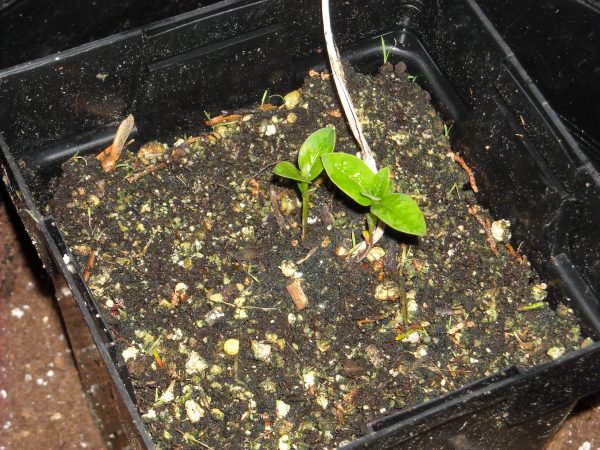
An update on a long-standing project that is — finally (I think) — yielding desired results.
Background: 3-4 years ago I purchased seed from an Etsy seller that was represented to be Purple Milkweed, a very desirable (but rather rare and expensive, in spite of being endemic in US) and beautiful species of Milkweed. A ‘tell’ that the seeds were not the advertised species should have been the photo at the Etsy listing, which I recognized from an out-of-stock seed seller with his own website. The Etsy seller did not photograph his own blossoms, but lifted someone else’s photo. That was a bad sign.
I did not heed the back-of-mind worry about this, and ordered the seeds. I got two seedlings to survive to maturity but they did not blossom the first year. The second year, they did blossom, but not purple. The plant is Common Milkweed, another endemic inUS species, and a good one to have. It’s a vigorous plant and if you like Milkweed it will not disappoint as it spreads vigorously both by seed and by underground running.
I will leave my colony in place as it will draw the Monarchs to lay eggs on it and perhaps spare seedlings of the more desirable Purple, which are so small that they would be destroyed by the caterpillars.
In late 2019, I purchased seeds from a better seller (Prairie Moon Nursery), but botched the cold treatment and in 2020 I got 7 seedlings out of 160 seeds. Then I put organic fertilizer in the seedling pots, and this drew the interest of the local squirrel population, which promptly dug the seedlings out of their pots in search of the delicious-smelling fertilizer. This was happening to all my starts and I invested in humane capture traps and removed the offending pests. Squirrels appear to have a significant lack of self-control when enticed with peanut butter. I always put a lot in the traps so that they would have something to occupy themselves with while awaiting transport into exile. Interestingly, there are no squirrels in my garden this year, but the corvids are noisy. I wonder, uneasily, if they are gossiping about me. It is said that it is very unwise to offend a corvid; they remember and word gets around.
The attached photos are of the sole Purple (at least, I HOPE it’s Purple) survivor of this multiyear saga. It’s a disappointingly small plant (the black pot in the first 2 photos is 5″ square, which gives a sense of how small these “green shoots” are), but I will baby it and then push it and hope to actually SEE PURPLE BLOSSOMS by the end of Summer.
I cold-treated another batch of commercial Purple Milkweed seeds this Winter and got much better results — 30+% germination this year versus 9% last year. The trick appears to be setting up the germination trays in late Autumn and leaving them outside all winter. This works best if the trays have drainage holes as otherwise the trays may fill in rainfall and the seeds may wash out. The dismal 9% rate in 2020 was for seeds cold-treated in a refrigerator. Outdoor is working much better and I am still getting new seedlings, perhaps “intentional” stragglers that serve as a safety measure in case a late frost kills the main population that germinated on schedule.
If I get actual purple blossoms this year, I will send some triumphant photos. This plant gets quite big in subsequent years and I hope tohave a mass planting, which should be an appealing sight.
Sounds like a great project. Readers, more like this please!
Readers: Water Cooler is a standalone entity not covered by the recently concluded and — thank you! — successful annual NC fundraiser. So if you see a link you especially like, or an item you wouldn’t see anywhere else, please do not hesitate to express your appreciation in tangible form. Remember, a tip jar is for tipping! Regular positive feedback both makes me feel good and lets me know I’m on the right track with coverage. When I get no donations for five or ten days I get worried. More tangibly, a constant trickle of donations helps me with expenses, and I factor in that trickle when setting fundraising goals:
Here is the screen that will appear, which I have helpfully annotated.
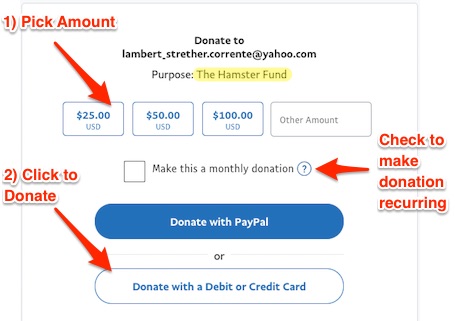
If you hate PayPal, you can email me at lambert [UNDERSCORE] strether [DOT] corrente [AT] yahoo [DOT] com, and I will give you directions on how to send a check. Thank you!2:00PM Water Cooler 6/8/2021


I am dying to see photos of the elusive purple milkweed! Is there a Latin name so I can look it up? Nevermind, found it. Asclepias purpurascens. Never knew about this before.
I recall reading somewhere that it is important to plant local native varieties of milkweed so as not to confuse the migratory flutterbyes. Do we have any entomologists among us?
It’s a good point. Here’s a USDA map of the distribution of this species in US & Canada
https://plants.usda.gov/home/plantProfile?symbol=ASPU2
A plant that probably should not be grown is A. curassavica , aka “Tropical Milkweed”.
https://entomologytoday.org/2015/01/16/planting-the-wrong-kind-of-milkweed-may-harm-monarch-butterflies/
Thanks.
Not an entomologist (and don’t play one on TV), but three years ago I started a pollinator garden and planted my first milkweeds. I pulled up a few starts of common milkweed (Asclepias syriaca) from a big patch along the railroad tracks. They definitely don’t like being transplanted, but they did grow, and in the first year attracted a few Monarchs, even though they didn’t flower..
They survived the winter, but the plants that came up weren’t vigorous and didn’t flower. I saw only a couple of Monarchs and one lone caterpillar, which apparently fell off its leaf and died in a storm with rain and high winds. Later in the season, I collected several pods from an impressive stand of 7-foot plants near an abandoned building down the street. I kept some of the seeds indoors and planted the rest in the garden.
Last year was just an off year all around, I think due to the late winter weather in mid-May. Underground, however, was a flourishing milkweed ecosystem. Once a few plants are established, the roots spread aggressively (definitely wouldn’t put them near a foundation). Also, small plants were coming up where I planted them, and here and there where I didn’t, likely from the seeds that “got away.” Frankly, I don’t see why they need to be babied, when they propagate both by seed and via underground roots. Of course, that’s “just” common milkweed.
Which brings us to this year. The plants are growing like — well, weeds! They are vigorous and about to flower. When that happens, I will send photos to Lambert. I think they actually liked this past winter, among the harshest in recent years. They got a good, long dormant period — historically, the climate here.
As for the variety, there are several varieties of native milkweeds, of which purple milkweed is indeed one. There are a few others. However, if the point is to create habitat for Monarchs and not eye candy for the gardener, why not go with what’s most plentiful in your region — what Monarchs are most familiar with — and easiest to find and grow? If you want more color, try interplanting milkweeds with echinacea, a.k.a., purple coneflower. Although I saw few Monarchs last year, the echinacea attracted huge, gorgeous swallowtails. Yellow Coreopsis also attracts pollinators. And if it’s eye candy you want, the three-plant combo is lovely.
Both Purple and Common are present here and there in my region. My preference for Purple is mostly rooted in unease regarding the invasive character of Common. My long-term goal for this project is to save seeds and distribute seeds and plants to people locally who want to plant Monarch habitat. Being somewhat less “weedy”, Purple seems to me a less off-putting plant to offer people; requires less maintenance and is somewhat more attractive in appearance than Common. And because it’s pricey when it can be found (and it is hard to find), I expect that people will be very pleased to receive it gratis.
Yes, I do have Purple Coneflower starts, in abundance; they did really well with the outdoor cold-treatment method. With 2 seeds per cell, many of my 72 cell starting trays had over 100 seedlings; the germination rate was much higher than I was expecting based on prior experience of indoor cold treatment of this seed.
I’m dying to have purple blossoms to show. This year’s “cold-treated” from-seeds starts are actually doing better now than the lonely survivor pictured in the plantidote. I moved two foot-tall plants into soil yesterday in hope the extra root freedom will promote rapid growth in the heat and blossoms by mid-Summer.
The saga is even more convoluted than the plantidote caption indicates. There almost were no 2021 starts at all, which would have left that pathetic pair of shoots as the only plant on hand now. Prairie Moon notifies customers (one must “opt in”) of A. purpurascens seed availability and (I later learned) the 2020 seed harvest was so disappointing that they didn’t send out the notifications on the customary date. In late Autumn I called to inquire whether seeds would become available and they offered to sell me a pack from the small harvest, and then within a day or two sent out the notification, and within hours were sold out. If I hadn’t called I probably would not have got any seeds for this “cycle.”
The customer service person was very helpful and, in response to my inquiry about my disappointing in-fridge cold-stratification results in early 2020, suggested a mass outdoor Autumn sowing in a big pot to get the benefits of “natural” cold treatment but with the boundary control of the container. In the end I elected to use regular starting “6-packs”, but made the mistake of not getting slotted trays to hold the packs and they overflowed in the weather and some seeds probably washed away.
I have more than a dozen healthy starts from that spur-of-moment call (modulo some frights along the way, such as attacks by aphids and “waxy” insects in recent weeks) and the thought occurs that if the plant doesn’t hybridize with my Common colony, I might be able to repay the favor and send seeds back to the seller, or perhaps I can simply give away seeds and plants locally.
A method-improvement for 2022 will be to bring the trays indoors in March in order to accelerate the germination; the 2021 trays remained outside throughout late Winter and Spring and didn’t start germinating until April.
Another intriguing thing is that I have noticed Ladybugs hanging around the Milkweeds this year at a much earlier point in the Spring than last year, when there were serious aphid infestations and relatively few predator bugs. There’s generally one Ladybug visible on the upper leaves of a plant, and I see very few aphids. Maybe I have a favorable predator/prey equilibrium. (Certainly not by my design!)
Here’s hoping there are purple blossoms to share later in the year.
Most hearty congratulations to you, Milkweed Dad.
The best tool for a gardener is patience. Many pits, seed, cuttings and other starts that I gave up on and never got around to dumping in the compost have produced three or four months after I thought they would.
As to squirrels, lay chicken wire on top of your pots, which should all be the same height, or, on the ground on top of seeds, pits etc, planted. Use big wire staples, the kind for water tubing, to pin down the corners. They may dig, but the half inch squares mean they won’t get very deep.
See you tube for How to make sweep potato slips…it works!
How’s Yves doing?
Agree with your sentiment, but hope that no news indicates good news. I will wait for a contrary report. Yves will do very well unless we are advised otherwise. She is strong and willful.
Yves flew home and is now in Birmingham!
Thanks for the update.
The various strange and amazing skull shapes, head crests, etc. of some of the duck-billed dinosaurs are considered to be bio-trumpets, sound-amplifiers, etc. of various kinds. So some dinosaurs at least were noise makers for important purposes.
https://images.search.yahoo.com/search/images;_ylt=AwrJ7Fxb5sxgk8UATwFXNyoA;_ylu=Y29sbwNiZjEEcG9zAzEEdnRpZAMEc2VjA3Nj?p=duck+billed+dinosaurs+acoustic+skull+features&fr=sfp
And the “beautifully singing” perching birds of today are not singing to please humans with their sonic beauty. Every birdsong translates to . . . ” This land is mine, get the f-ck off it.”
I don’t agree. Our local Parrots fly over a huge area , continually squawking.
It appears more of an “I’m over here” call, as opposed to defending territory.
And then there are other birds with mating calls.
Or mockingbirds attracting predators with their calls to protect their young.
Territory protection is only one reason, but there are others and I believe bird song much more complex than your assertion.
The sparrows in my barbary say to each other, “I’m a sparrow, your’e a sparrow!” most all of the daylight hours, enlivened by the occasional, “Hey, honey, I’m in the mood.”
Good points about the multiple purposes of bird-song. I will still re-note that some dinosaurs were clearly sonic.
And that of all the different reasons wild birds sonicate, pleasing people is rarely if ever one of them
A few minutes after reading your comment, I heard a commotion of bird squawks coming from the back area between the buildings. I stepped out to see what was up and saw that a grackle was sitting along the back wall along with a male sparrow and what could have been female sparrows or finches. There were two species present at least and they were all staring down into the space below the wall and chattering to one another.
I walked closer and coughed to announce myself. They ignored me until I got a few feet away then all took off into a nearby tree to continue the conversation. I stepped to the edge of the wall and peeked over. About thirty feet down was a housecat in an enclosed yard, staring up at me with an unpleasant glare on it’s face. I got the sense it was sizing me up.
Hmm. T’other morning I walked out to hang up clothes in the back yard. There was an agitated robin on the clothesline unmistakably shouting, “Cat! Cat! Cat!” Which was true. I shooed the cat and go That Look. I rarely see robins in my yard, so maybe he was neighbourhood watch?
My (personal) favorite bird story. Came home to make a quick PB&J sandwich. Out the kitchen window a scrub jay (blue jay family) was really screaming from a tree. It was their warning call. I imitate it to keep them out of my fruit trees when they ripen. It was being real insistent so I went out to shew it away. It got my attention and I realized it was telling me that the neighbor’s young cat had become stuck in the crotch of a limb. The cat was hanging by it’s hips and couldn’t grab another limb to get free, so it had wedged itself with it’s own weight. Poor kiddo had just passed and was still warm.
The Jay was yelling “hey buddy, your cat is stuck”. My guess was that the bird was messing with the cat and the rough house went a bit too far. Sad, but in a way, beautiful. The scrub jay was trying to help.
Mississippi Delta blues:
Lightnin’ Hopkins – It’s A Sin To Be Rich, It’s A Low-Down Shame To Be Poor
https://youtu.be/6xTQxSkTXww
North Mississippi AllStars – Shake ‘Em On Down
https://youtu.be/N5guqFpsZ5E
R.L. Burnside at The Cooler (05-14-1996)
https://www.themckenzietapes.com/tapes/2018/5/17/rl-burnside-at-the-cooler-05-14-1996
The McKenzie Tapes is a collection of live audio recordings from the New York City-area’s most prominent music venues of the 1980s and 1990s.
Play Delta blues guitar: 10 lessons by Rev. Robert Jones
https://www.youtube.com/watch?v=ndhFr058Tl8&list=PL2TrPkuyjM4c7aiZIr7VN-1X__R6FRGIv&index=1
Not really hard, if you learn the right licks.
Robert, one of my favorite Lightnin’ songs. Influential to me as a kiddo. Used to sing it (excluding a few words) to my grade school kids when we discussed race relations. Replaced Morgan David with animals and vegetables. Exceptional https://www.youtube.com/watch?v=hpQ6ih0R_zY
Stay flat five!
Mississippi Hill Country Blues, it’s Bad You Know https://www.youtube.com/watch?v=_ZncehIh_Kw
two thumbs up Robert
Thank you bandit, I agree but every time I bring this up to people they act like I am a conspiracy theorist. People apparently believe with no proof whatsoever that the CDC is looking out for them.
Thank goodness for NC
RE: Covid positivity (South positivity falls off a cliff)
Lies, damned lies, and statistics. As you can see from this chart at 91-DIVOC, the South reported 24,462,743 tests administered on 6/17. But it all evens out, because they administered negative 24,264,694 tests on 6/14.
My electronic thermometer tells me its 111.2 degrees.
The weather service temperature at the Fresno air terminal is a frigid 107. Brrrrr
Well, 107 K is -267.07 degrees F ;-) Channel that!
111 family blogging degrees here in Tucson. My garden is not happy. Neither am I.
116 in Phoenix. My summer garden is mostly sweet potatoes, and they are doing fine.
All right, ‘fess up. Where did you get your sweet potato starts?
And is it too late to plant them?
Can’t you start sweet potatoes by cutting chunks around an eye much like normal potatoes or am I delusional?
You may have better luck doing this with organic sweet potatoes. Commercially grown potatoes are often sprayed with a growth deterrent to keep the potato eyes from growing thus reducing your yield.
I experimented with sweet potato eyes last year and was astounded at how many potatoes that grew from a single eye. I will indefinitely grow them again. Purchasing shoots might provide even better results.
116? I have no idea what you guys are talking about. There is a chilly wind blowing and it will be only be about 20 degrees today – about 68 in Fahrenheit – in our neck of the woods. Of course we are in the middle of winter here and the shortest day of the year is on his coming Monday so there is that. :)
Oh, stop!
Alas! How could you wonder when dinosaurs might sing, and when they might have learned and why?
It’s all about Love! Dinosaurs may have been big scary monsters but that does not mean they could not feel Love … and Love is the Mother of Song. Why? Why did they learn to sing!? Who — who has truly loved did not learn to sing and voice poetry to their Love?
Greenwald weighs in on the FBI/Capitol riot controversy
more
https://greenwald.substack.com/p/questions-about-the-fbis-role-in
It has been surprising to me that the usual alternative media sources such as useful idiots, Krystal and saagar, the Jacobian, Etc have not picked up on the Ivermectin story. Now finally, Matt Taibbi has put an article out about it, so hopefully it’ll start to get more traction among our alternative media allies. The article is @tk news, Matt Taibbi substack account, and I got an email for it today. Unfortunately I don’t know how to share a link to that
https://taibbi.substack.com/p/why-has-ivermectin-become-a-dirty-7bd?
The subject of better things than lawns to do with a yard has come up from time to time, and here is a subReddit called “No Lawns” which I found on Ran Prieur’s blog.
https://old.reddit.com/r/NoLawns/